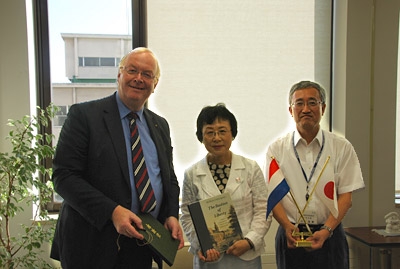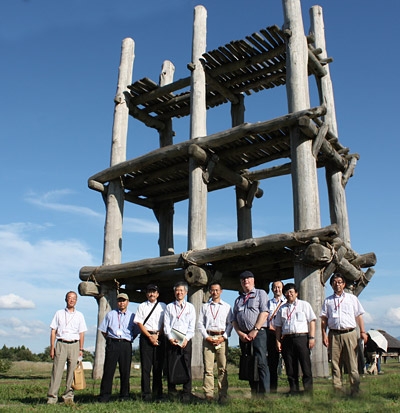15 prehistoric Jomon Culture sites in northern Honshu and Hokkaido
Dean prof. Willem Willems has visited Japan from 8-10 September, at the invitation of the Aomori District Council in northern Honshu. Purpose of the visit was to provide assistance in the nomination process for World Heritage Site of 15 prehistoric Jomon Culture sites in northern Honshu and Hokkaido.

Professor Willems meets with superintendent mrs. Miyako Hashimoto and vice-superintendent Mashahiro Kawamura of Aomori Prefecture Board of Education
The planned serial nomination encompasses sites that reflect the chronological, spatial and functional differentiation of the Jomon Culture, with very early pottery and a subsistence based on hunting and gathering that lasted for a very long time, a period from 13.000 to about 500 BC. The intended nomination will encompass world famous sites such as the Oyu Stone Circles and the habitation site of Sannai Maruyama (see picture). Extensive discussions took place during two round tables and a number of site visits.
Prof. Willems is co-president of ICAHM, the ICOMOS International Committee for Archaeological Heritage Management, and the visit fits into the policy of ICAHM to help States Parties to the World Heritage Convention with nominations of archaeological sites. As part of that same policy a delegation of ICAHM has recently visited the prehistoric site at Poverty Point (Louisiana, USA) and in November will launch the 'Africa Initiative', at an ICAHM Sponsored Session and ICAHM Annual Meeting during the joint Panafrican Association/Society of Africanist Archaeologists Conference at the University Cheikh Anta Diop in Dakar, Senegal.

Visiting the famous Sannai Maruyama site, the largest Jomon site discovered on Japan, with hundreds of pit dwellings and 20 long houses. It was discovered in 1994, as part of a rescue project ahead of a baseball stadium construction but retains very substantial undisturbed deposits.
The activities also fit in the growing interest at the Faculty of Archaeology in the Archaeology of East and Southeast Asia. This has recently become a master specialisation again, and the Faculty has entered into an agreement with the Neomap Project in Japan, through the research activities of dr. I. Bausch. At the same time, various PhD candidates work on dissertations concerning heritage issues in for example.
